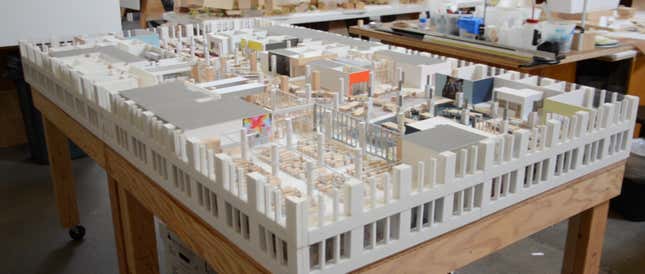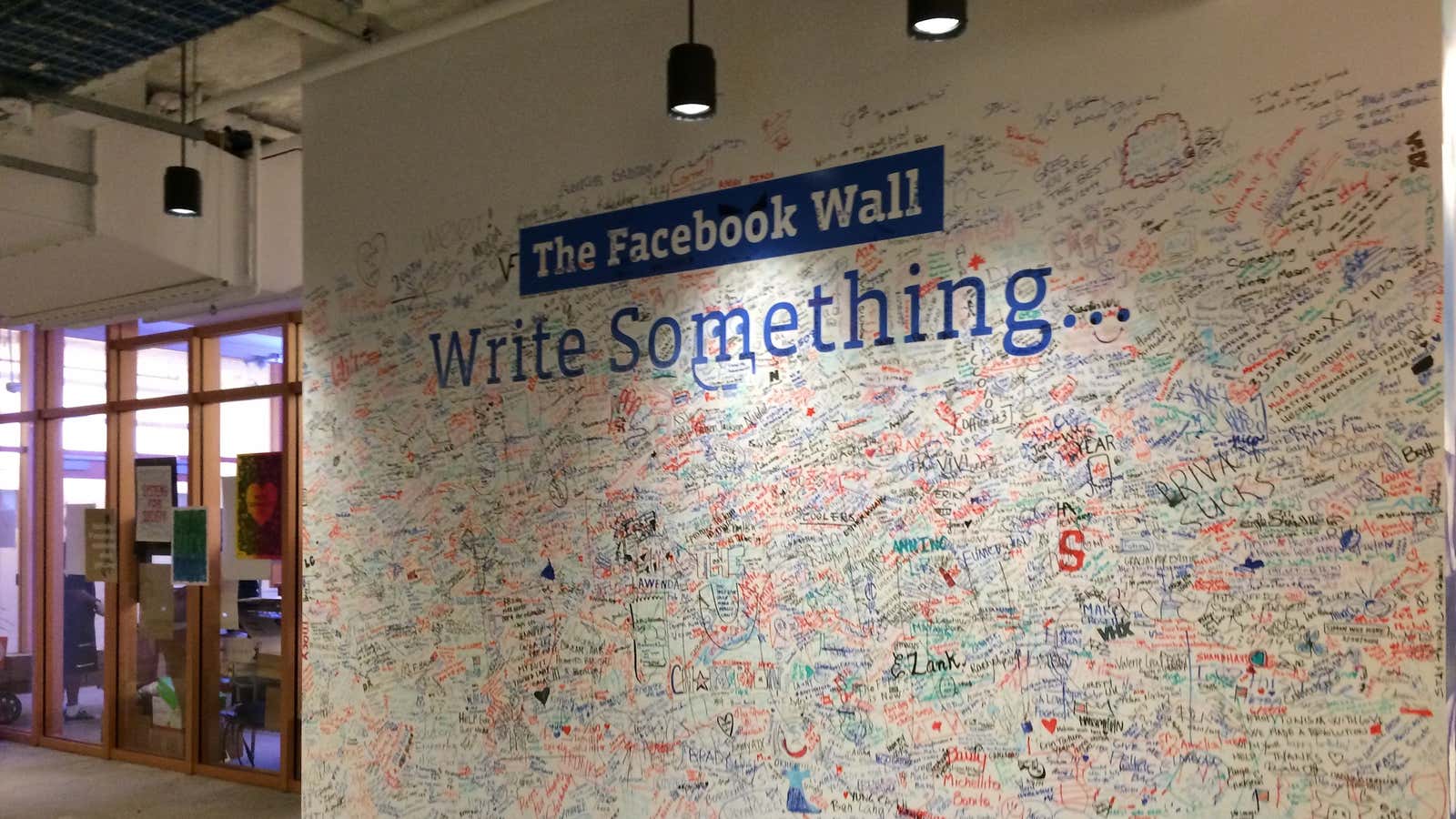A short elevator ride from New York City’s humid bustle is Facebook’s brand new office, a raw airy, open-plan space that manages to be luxurious even in a half-finished state. Look around, and there are plenty of signs that you’re in one of those fancy technology spaces that have become part of the appeal for Silicon Valley companies: a big, extremely well-stocked snack kitchen; a cafeteria under construction downstairs that will serve employees free meals; a coffee bar with a bewildering array of brewing apparatus; a cocktail bar overlooking Astor Place.
In late June, walls were plastered with rainbow stickers and posters for the upcoming LGBT pride parade. I met the site’s director in a room named for a character from the main antagonist from the movie Ghostbusters, complete with a model Stay Puft marshmallow man. All those amenities and quirky touches helped Facebook earn its reputation as a great place to work. But the Frank Gehry-designed office also reflects an engineer’s practicality, says site director Serkan Piantino.
“We don’t have a slide; we don’t have things that I think might have been interesting but not functional,” Piantino says. “We have a coffee bar because people love coffee. We have a library because we do a lot of research, and people need a space to do some reading or get away from the hubbub of New York.”

The office is about one-third programmers, including parts of the company’s artificial intelligence group and much of its location team. Piantino is a Facebook veteran who was part of the teams that built the social network’s newsfeed, timeline, and messaging systems. He’s been leading the development of a New York engineering office since it was just an idea in 2011.
Piantino helped pick the new location based on data on where employees lived around the city and nearby transit options, and to design the space. He wanted to create an office that not only would provide everything people needed to do their jobs, but also would be a genuinely pleasant place for work that doesn’t push people out at the end of the day.
Engineering finds its way into the company’s office and management culture in both subtle and explicit ways. Immediately when you walk into the office, a big screen shows its floor plan, complete with a label for each room, color-coded based on whether it’s occupied or free for the taking (via in-house software for booking meetings and rooms called Wayfinders). There are also small touch-screen panels in front of each room, quickly letting you know whether a room is occupied and for how long.
This may seem like a lot of technology just to determine when a conference room is free, but anyone who has spent time trying to find a room in an unfamiliar office, or to tactfully kick someone out before a scheduled meeting, can appreciate why it might appeal to Facebook’s engineers.

There is a history of internal productivity tweaks at Facebook. Dustin Moskovitz, one of the company’s founders, left Facebook with Justin Rosenstein to form productivity software company Asana. The platform is based on internal tools the pair helped develop at Facebook, that are still in use there.
It’s all part of an overall management philosophy that is highly practical. Piantino passed along some management lessons he has learned in nearly seven years at the company, applicable even to those of us without Frank Gehry offices or computer scientists building us bespoke productivity hacks.
It’s a philosophy of sometimes doing things the hard way, but planning ahead to remove friction.
Move people around, even if it’s difficult
Facebook doesn’t hire engineers with an exact job in mind and send them directly there. Instead, new hires go to Bootcamp, a highly regarded training program for new employees on the engineering side—from freshly minted computer science majors to product managers who probably won’t ever write code on a daily basis. Venture capitalist Ben Horowitz calls Facebook’s Bootcamp one of the best employee training programs that exists.
At Bootcamp, new hires join with a class of other people, work with a variety of engineers, and push a piece of code live onto the site within their first week. And at the end of it, rather than being assigned somewhere, engineers pick the team where they end up.
And even once employees choose their trajectory at the company, they’re expected to keep moving, Piantino says. A “hack a month” program lets people test out new teams and projects briefly. Movement is not just allowed; it’s encouraged. If a worker has been on the same team for a year and a half, managers will suggest a switch. ”We will actually start sending nag emails,” Piantino says.
All this movement actually creates a lot of extra work for managers at the company. ”It makes our jobs more difficult because you have this flux of people that might be leaving and trying something new,” Piantino says. “The fact we encourage people to pick their teams out of bootcamp makes it harder for us to be really precise about how we allocate resources.”
Still it’s more than worth the effort, he says, to be certain that people are working on things they’re passionate about.
Management should not be a promotion
It’s an inevitable fact that as companies get larger, a substantial management layer builds up. At many companies, management is seen as a reward for excellent performance. It often ends up being the only path to increase influence and compensation at a company, so people pursue a promotion to management regardless of whether they are well-suited to the role.
At Facebook, Piantino says, management is “always a horizontal shift; it’s not typically a promotion.”
The company reassures workers that they can increase their impact and acclaim by continuing to make things every day. ”We take great care to make sure that there’s not an incentive for people who want to get to the next level in their career, to make that management,” Piantino says. “You see that a lot in organizations: It’s sort of a natural thing, and it’s very unhealthy. We go to great pains to make sure that there are equally great and and challenging individual ramps that go up to the point where we expect someone impacts the whole industry.”
Workers opt in to a management position after trying it out to see whether they like it and can do it well, Piantino says: ”We have these ways where you can mentor people through boot camp or have an intern for the summer, or you can sort of tech-lead a smaller number of people and get a sense of what it’s like.”
That can smooth the transition from spending all day writing code to the responsibilities of meetings, coaching, and management. More importantly, it means the right person gets the job—someone who wants to do it, and has shown some talent for it. Once he or she starts on the management path, there’s plenty of training and support.
Give people time and resources to do—and build—interesting things
The worry at a big company is that everyone gets assigned a relatively narrow task, something that’s going to be boring and demotivating for the sort of high-performers that Facebook works very hard to attract. Through hackathons and the like, the company makes space for workers to try new stuff.
And it’s not enough just to have an aspiration and give permission. At Facebook, a great deal of time and effort goes into making it very easy for engineers to try new things on a daily basis. There are whole teams at Facebook dedicated to product infrastructure, to making it “easy, safe, and great” to work in the company’s code base.
“The other secret sauce is that it’s really easy to write code,” Piantino says. “we invest a lot of time in developer efficiency so that people can prototype easily.”

There’s an effort to foster a culture where there’s a heavy emphasis on prototyping and experimentation. ”A lot of the best products we ever had probably wouldn’t make sense if you were to put together a Power Point,” Piantino says. “But once people built a prototype and showed their coworkers, or just turned it on for people at the company, it was pretty clear there was something valuable.”
Facebook’s chat, which started from a hackathon, is an example. Initially, it was met with skepticism, but it ended up being one of the best and most-used products on Facebook. Many other products have followed a similar arc, Piantino says.
“There’s a culture we have about shipping things; people want to build things and watch people use them,” Piantino says. “It’s sort of the joy that we’re all chasing. The way we like to say it is that code talks louder than words.”
